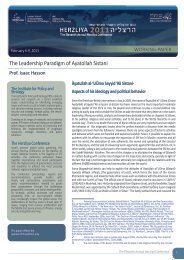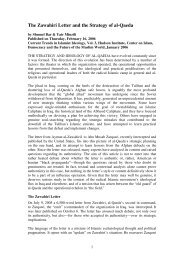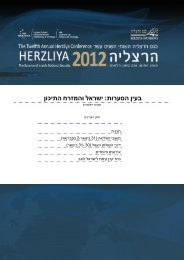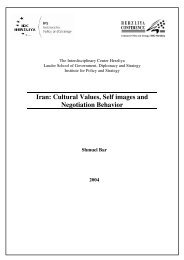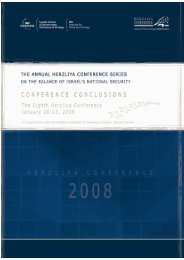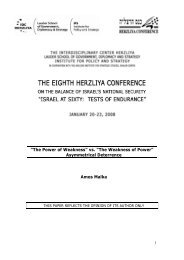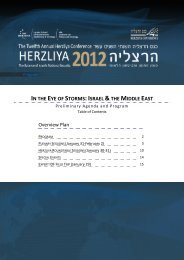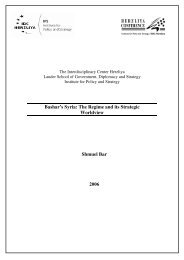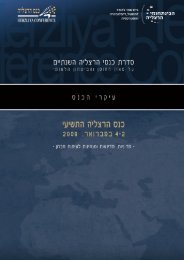Classical Islamic Paradigms of Deterrence and their Expression in ...
Classical Islamic Paradigms of Deterrence and their Expression in ...
Classical Islamic Paradigms of Deterrence and their Expression in ...
Create successful ePaper yourself
Turn your PDF publications into a flip-book with our unique Google optimized e-Paper software.
to be recruited <strong>in</strong>to tribal <strong>and</strong> jihadi networks who battle aga<strong>in</strong>st the Pakistani state <strong>and</strong> are <strong>in</strong>fluenced by aglobal jihadi agenda.Transition from Conventional to Alternative <strong>Deterrence</strong>If targeted repression does not work properly, other means <strong>of</strong> controll<strong>in</strong>g terrorist threats must beconsidered. If the U.S. considers comprehensive deterrence strategies aga<strong>in</strong>st salafi-jihadis, then the latterforce has reached a level <strong>of</strong> power <strong>in</strong> U.S. perception that makes it an equal opponent. One answer to thisis to create an effective threat balance. Salafi-jihadi power cannot be seen <strong>in</strong> absolute military terms, but asa conglomerate <strong>of</strong> military, ideological, network, support <strong>and</strong> communicational capabilities. If thesecapabilities are exam<strong>in</strong>ed, then several difficulties come to m<strong>in</strong>d. Salafi-jihadis are non state actors whoapply terrorist tactics. Their ideology is rooted <strong>in</strong> broader Muslim dissent aga<strong>in</strong>st Western <strong>in</strong>fluence <strong>and</strong>socio-political <strong>in</strong>equalities <strong>in</strong> Muslim countries. This does not mean, however, that Muslim populaces canbe held responsible for salafi-jihadi actions, <strong>and</strong> therefore, they cannot be addressed with threat scenarios<strong>in</strong> order to deter salafi-jihadis. Another factor that comes to m<strong>in</strong>d is the communicative control <strong>and</strong> theideological strength <strong>of</strong> salafi-jihad. It creates followers <strong>and</strong> networks worldwide. Even if most followers <strong>and</strong>sympathizers do not perpetrate terrorist attacks, the idea <strong>and</strong> worldview <strong>of</strong> global jihad is sownsuccessfully <strong>in</strong>to <strong>their</strong> m<strong>in</strong>ds via the Internet <strong>and</strong> its <strong>in</strong>formation possibilities. If the communicational l<strong>in</strong>kbetween authorities <strong>and</strong> followers could be targeted <strong>in</strong> a way that forces followers to perceive a higher costthan benefit, then they might give up support<strong>in</strong>g salafi-Jihad.Another problem is the idea that salafi-jihadi actors will not answer tit for tat to threat scenarios accord<strong>in</strong>gto Western cultural perceptions. The approach <strong>of</strong> "If you have a bomb <strong>and</strong> I have a bomb, then both <strong>of</strong> uswill not use it" might be erroneous. <strong>Islamic</strong> rationality must be understood <strong>in</strong> conjunction with religioushonor <strong>and</strong> mythology that needs to be calculated when build<strong>in</strong>g threat or deterrence scenarios, especiallyso when speak<strong>in</strong>g about the most radical fr<strong>in</strong>ges <strong>of</strong> salafi-jihadism. Under severe pressure, the pendulum <strong>of</strong>religious ratio tends to sw<strong>in</strong>g towards millenarian <strong>and</strong> apocalyptic visions. This problem might be solved bythreaten<strong>in</strong>g essential earthly goals, not transcendental objectives <strong>of</strong> salafi-jihadis to keep them <strong>in</strong> check.However, the author expresses his s<strong>in</strong>cere doubts that salafi-jihad can be checked with a conventionalthreat strategy. Threaten<strong>in</strong>g the transcendental objectives <strong>of</strong> salafi-jihadis could keep them <strong>in</strong> check. Itshould be complemented with a communicational <strong>and</strong> political strategy that dim<strong>in</strong>ishes the sympathyamong larger Muslim populaces for radical Islam <strong>and</strong> dra<strong>in</strong>s the pool <strong>of</strong> support <strong>and</strong> communication forsalafi-jihadis. F<strong>in</strong>d<strong>in</strong>g out further venues will be the next analytic step.L<strong>in</strong>guistic <strong>and</strong> Religious-Psychological ApproachesPerceptions <strong>of</strong> salvation <strong>and</strong> non-deterrability should be attacked at <strong>their</strong> very ideological roots (See parts7.b,c <strong>and</strong> d <strong>of</strong> this paper). Some jihadi groups may be held <strong>in</strong> check if they start doubt<strong>in</strong>g <strong>their</strong> own culture.Culture can be described as "a web <strong>of</strong> signification spun by mean<strong>in</strong>gful actions, objects <strong>and</strong> expressions." 132Ideology with<strong>in</strong> culture serves the construction <strong>of</strong> collective identities through l<strong>in</strong>guistic <strong>and</strong> psychicprocesses. 133Propag<strong>and</strong>a is the carrier <strong>of</strong> ideology. The most visible proponents <strong>of</strong> salafi-jihad, i.e.ideologues who run <strong>their</strong> own websites or belong to terrorist organizations with own media companies,should be directly criticized <strong>and</strong> attacked with valid counter-arguments. The aesthetics <strong>of</strong> terror whichthese ideologues sow via the Internet should be targeted with counter-narratives.132 Nick Stevenson, "Underst<strong>and</strong><strong>in</strong>g Media Cultures. Social Theory <strong>and</strong> Mass Communication", London, Sage, 1995, p. 77.133Stevenson, Underst<strong>and</strong><strong>in</strong>g Media Cultures, p. 37.41



